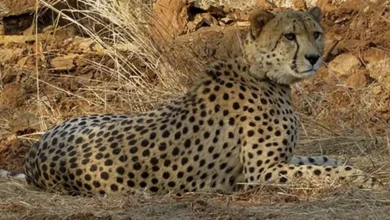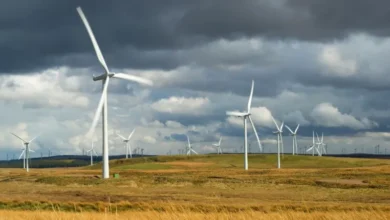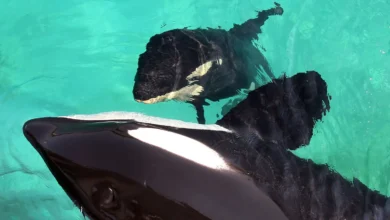Riders on the storm: The birds that fly into hurricanes
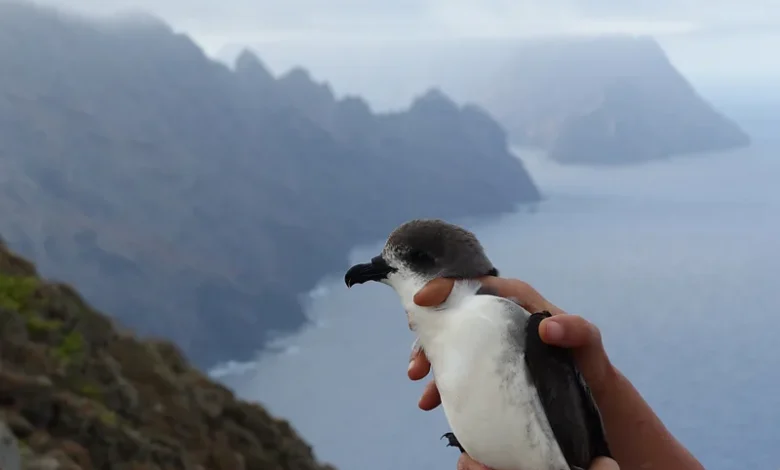
When hurricanes pass over the ocean they churn up creatures from the deep – a chance to feast for predators brave enough to weather the storm.
High on a rocky plateau, one small nocturnal seabird is nestled in its burrow, where far below waves lap gently against the cliffs. In the blackness of night, it senses a storm brewing 1,000 miles (1609km) from the coast of Morocco.
Drawing energy from the warmth of the ocean’s surface, a tropical cyclone begins to form until a powerful column of rotating air is marching across the globe. The cyclone the bird senses is hundreds of miles wide, and lightning strikes speckle its outer bands, while 150mph (240km/h) winds churn the ocean waters below.
Hurricanes are known for their destructive force. Seabirds will often forgo foraging trips and stay ashore when they sense a storm is coming, or they’ll fly hundreds of miles to circumnavigate the dangerously strong winds. Frigatebirds climb to extreme altitudes to quickly bypass a cyclone at high speeds, and even albatrosses – known for their ability to fly in high winds – seek calm in the eye of the storm.
But not all animals see them as a threat. For some, the fearsome energy of the storm provides a banquet, as delicacies from the ocean depths – like squid, octopus and cuttlefish – are dragged up to the surface.
One such predator is the Desertas petrel, a small agile seabird with long slender wings. This petrel seeks out the most powerful storms, seeing an opportunity to hitch a lift. It darts straight into the bands of spinning air, reaching areas within 200km (124 miles) of the eye of the storm.
“Honestly, I cannot imagine what the conditions would be like,” says Francesco Ventura, a biologist and postdoctoral investigator at US ocean research organisation Woods Hole Oceanographic Institution. “They’re pigeon-sized, just a few hundred grams, experiencing winds up to 100km/h [62mph] – most likely much more than that – and gigantic waves, with ocean swells up to 8m [26ft]. They’re really amidst the madness of the storm.”
When the tropical cyclone passes, continues Ventura, “the birds align their movement trajectory along the wake of the hurricane”. Now, this delicate little bird rides on the tail of the storm, foraging on creatures churned up from the twilight zone.
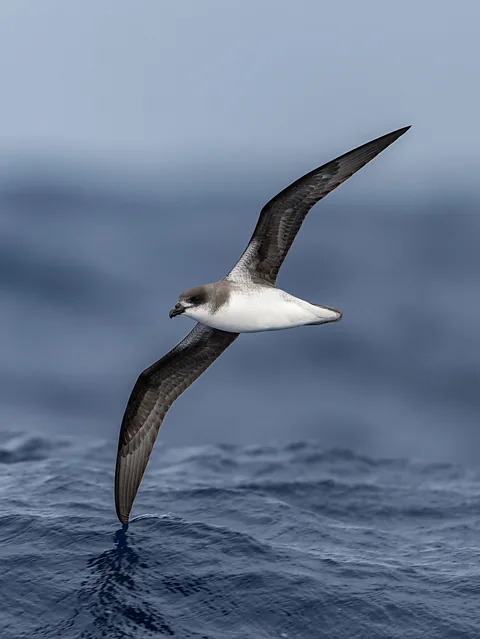
We’re all too familiar with the human tales of devastation associated with hurricanes, from lives and homes lost, to flattened and drowned cities. But these mega-storms also impact the oceans – turning life upside-down for the myriad creatures that live beneath the waves.
Tropical cyclones – otherwise known as hurricanes or typhoons, depending on where they crop up in the world – churn the ocean as they travel, thrusting warm surface water into the depths where it is trapped and can travel for thousands of miles before resurfacing. Meanwhile cool water wells up from the deep.
This underwater turmoil can have a profound negative impact on oceanic and coastal ecosystems, stirring up the seabed, destroying turtle nesting sites and decimating shellfish beds, sending migrating animals miles off-course, and smashing through delicate coral reefs.
However, this ocean churning can also kickstart phytoplankton blooms as the nutrient-rich waters rise to the upper layers of the water column. Zooplankton and other tiny swimming prey are followed by larger predators such as small fish and cephalopods usually found in the ocean’s “twilight zone” at 200-1,000m (656-3,280ft) depth. All this makes for a delicious treat for predatory seabirds like the Desertas petrel.
They put themselves exactly in the right place at the right time to be run over by a hurricane – Francesco Ventura
“There are only 200 breeding pairs in the whole world,” says Ventura.
Desertas petrels spend their lives foraging far out to sea, but until recently scientists knew very little about where they went. “We only had some hints, some clues, from the fact that sailors would see them very, very far off the coast. And fishermen would see them thousands of kilometres away from land.”
It was in 2015 that Ventura and his colleagues first set out to uncover the secrets of these birds’ mysterious lives over the open ocean.
To reach the nesting site, Ventura had to climb the near-vertical cliffs to the top of “a ridge sticking out of the ocean”. On top, the plateau was dotted with burrows. At night, says Ventura, “the whole island comes alive. You hear birds calling from underneath, from their burrows. You can hear them swooping and flying by fast to approach the colony. It’s an eerie sound – it makes you understand why fishermen were superstitious about these birds. It’s as if the island is talking”.
After attaching the super-lightweight GPS trackers onto the birds, Ventura waited. Two to three weeks later the petrels returned to their nests, and the trackers could be retrieved. “Then you connect the loggers to the computer, and you see that they went completely to the other side of the Atlantic, while the partner was sitting on the egg,” says Ventura.
Desertas petrels, the researchers found, make some of the longest foraging trips ever recorded in any species – travelling as far as 12,000km (7,460 miles) over deep, pelagic waters – all the way from Africa, to the New England coast and back again.
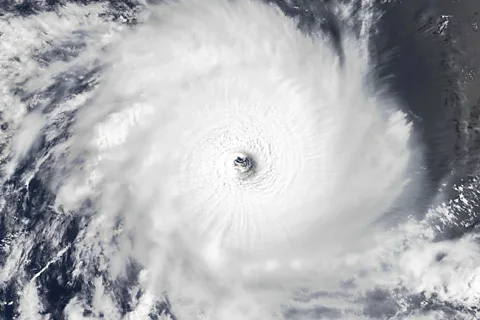
And, not only did the birds travel vast distances – they also put “themselves exactly in the right place at the right time to be run over by a hurricane”, says Ventura.
The team tracked 33 petrels as they made 43 foraging trips over four breeding seasons from 2015 to 2019. The data showed that when the Desertas petrels encountered tropical cyclones thousands of kilometres from land, they had an unusual strategy. Unlike other species of seabird, this “hypermobile flier” didn’t avoid cyclones, nor seek out the calm of the eye of the storm. Instead, they actively approached them, flying long distances towards cyclones, entering the storm, and then following their wake for thousands of kilometres, and several days.
“We found that, upon leaving the colony – and we’re talking about 900km [560 miles] away from a hurricane – the birds were choosing the path that would take them closer to the eye of the cyclone,” says Ventura.
Desertas petrels, he explains, are opportunistic hunters. To maximise their chances of encountering prey, these birds make extremely long foraging journeys. They use a technique known as “dynamic soaring” – moving between slow- and fast-moving air masses – which allows them to travel for long distances without flapping their wings, instead using energy from the wind.
They climb up across the wind shear layer – where there is a sudden change in wind speed and direction – gaining height. Then they descend downwind, then climb upwind again – and so on for thousands of miles, says Ventura. “They constantly adjust to the wind conditions, so that they can cover as much ground as possible, as fast as possible,” he says, adding that they likely encounter many cyclones over the course of the breeding season.
Desertas petrels are masters of energy efficiency. Their long slender wings give them excellent uplift and less drag, resulting in what’s known as a high aspect ratio. In fact, they have the highest aspect ratio per wing loading of all seabirds. This makes them especially anatomically adapted for fast gliding flight with minimal exertion.
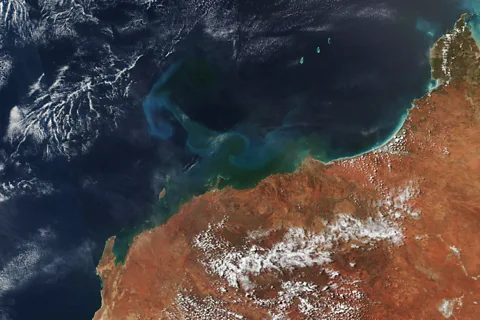 Nasa
NasaThese birds also appear to know the “wind scape” of the North Atlantic Ocean. They anticipate and respond to wind conditions at an ocean-wide scale, says Ventura, and their movements suggest they are familiar with the predictable prevailing North Atlantic winds.
Ventura and his team also monitored the sea surface temperature, which cooled as the storms passed over. Surface chlorophyll increased, suggesting a boost in phytoplankton. When this microscopic marine algae blooms, zooplanktons – tiny animals – come to feed on the phytoplankton. Then, in the relative safety of the darkness of night, deep sea creatures follow – like squid, hatchetfish and lanternfish – to feed on the zooplankton. Now, there is abundant prey for the hungry surface-feeding petrels.
Sometimes, though, strong winds do not work in animals’ favour. Other, less well-adapted, seabirds are often particularly hard hit. Strong winds can force seabirds off course, away from the places they need to forage. Between December 2013 and February 2014, for instance, almost 60,000 dead seabirds washed up along North-East Atlantic European coastlines due to winter storms – many of them had starved to death.
Riding the storm
Desertas petrels are not the only ones to use movements of the air to get where they want to go. Frigate birds, for example, reach extreme altitudes by riding updrafts through tumultuous cumulus clouds that tower as high as 13,000ft (4km/2.5 miles). And bats, too, make use of storms, surfing weather fronts which carry them on continent-wide migrations.
To avoid such disasters seabirds have been seen to change their movements to keep away stormy weather – and understanding these diversions, experts say, could help us to predict when a hurricane is on its way.
The Veery thrush is one such bird. A 2018 study found the this tiny songbird lays fewer clutches of eggs and leaves the nest earlier before a severe hurricane season. “Earlier departure might allow them time to adjust to inclement weather along their 5,000km [3,100 mile] journey,” says Christopher Heckscher, professor of environmental science and ecology at Delaware State University in the US and author of the report.
But how the veeries sense the severity of an oncoming hurricane season remains a mystery. Theories, says Heckscher, include shifting food resources prior to migration, an increase in rainfall or more Saharan sand entering South America. “Whatever it is, it’s important to realise that the veeries are not sitting around, planning this out. Something is happening to their physiology that results in change in reproductive behaviour – but whatever the mechanism, the bird is committed to their reproductive cycle more than three months before fall migration.”
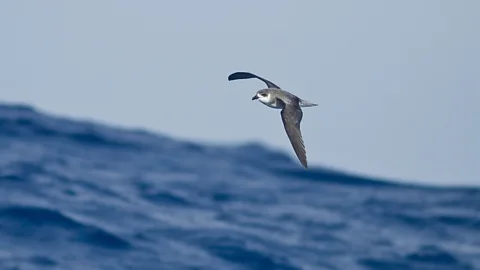 Alamy
AlamyBack over the Atlantic Ocean, as hurricanes Imelda and Humberto churn and bring extreme ocean swells, the Desertas petrels may already be on the wing far out to sea, says Ventura, surfing the wake, enjoying the feast served up from the deep.
“The ocean is bursting with life,” says Ventura. However, many species’ existence is tied to the ocean surface, so the abundance of food is just out of reach – until a hurricane turns the oceans upside-down that is. “We know the devastating impacts of hurricanes – but they are also punctual, they happen in a specific season.” It makes sense, he says, that these animals have evolved to take advantage of the winds, however extreme they may be.
“Chances are,” Ventura continues, “some birds may well be chasing Hurricanes Imelda and Humberto at this very moment – which is a pretty wild thing to imagine.”




